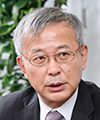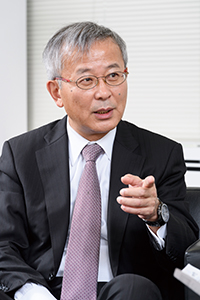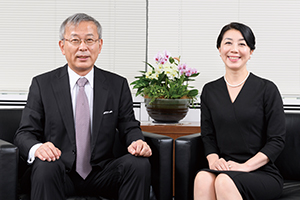 |
|
|
|
|
|
View from the Top Vol. 16, No. 1, pp. 1–5, Jan. 2018. https://doi.org/10.53829/ntr201801tp1  A Year for Refining Our Abilities to Become a Partner of Choice—Creating New Value for Our Customers through Outstanding Technologies and Collaborative SkillsOverviewGreat expectations are being placed on the NTT Group both inside and outside Japan to provide high-quality and stable network services, ensure a safe and secure network through advanced security measures, and provide a moving user experience and new value. The NTT Group itself is committed to solving social issues and providing new ways of creating value. How will the NTT Group approach these needs in 2018? We asked NTT Senior Executive Vice President Hiromichi Shinohara to tell us about his outlook and aspirations for the NTT Group. Keywords: B2B2X, collaboration, global 2017: A year of exciting developments—Mr. Shinohara, please sum up last year for us. What kind of year was it? In short, it was an exciting year! In November 2017, for example, the NTT laboratories and NTT DOCOMO conducted a worldwide streaming experiment connecting three global locations (Tokyo, London, and New York) to present a live, dispersed performance by Perfume, a popular three-member Japanese pop group. This experiment constituted part one of the FUTURE-EXPERIMENT project that aims to provide people with totally new experiences. The highlight of the experiment was a remote collaboration making use of NTT’s immersive telepresence technology called Kirari!, which uses Advanced MMT (MPEG Media Transport) high-presence media synchronization technology, and NTT DOCOMO’s 5G (fifth-generation) mobile communications technology. Given the task of achieving a live hookup from three different points in the world and making the separate dance performances at each of these locations appear as if they were taking place on the same stage, I was naturally quite tense. However, the result was an amazing success, with viewers seeing each member of the group dancing lively in step with each other. In addition, although the business-to-business-to-X (B2B2X) model that NTT is pursuing requires time to create something new through repeated trial and error, it expanded greatly last year through collaboration with NTT operating companies and partner companies. As a result, exciting new business opportunities were created. For example, in the manufacturing industry, collaboration between FANUC CORPORATION and the NTT laboratories, NTT Communications, and NTT DATA led to the service launch in October 2017 of the FIELD system (FANUC Intelligent Edge Link and Drive system), an open platform for achieving an unprecedented smart manufacturing site. Furthermore, in collaboration with Mitsubishi Heavy Industries, Ltd., NTT accelerated the development of InteRSePT—a cybersecurity technology targeting control systems for critical (social) infrastructures—and entered the finishing stage of the development. InteRSePT enables real-time anomaly detection and response against unknown cyberattacks to achieve safe and secure system operations. Our aim is to apply this technology to commercial fields such as thermal power generation facilities and chemical plants. In the sports industry, a virtual reality baseball coaching system developed with NTT DATA is now in use by the Tohoku Rakuten Golden Eagles professional baseball team. —It was certainly a year that produced material results in a variety of fields. What direction will this year take? Last year saw a shift from what had been a construction and production stage to a phase of actual use, or in other words, to the “genuine launch of business.” At the same time, we must expand services and products of the same kind to other companies in the same industry. This is not to say a haphazard expansion but the further penetration of necessary technologies in need-to-have industries through collaboration. In our approach, our objective is not to form associations with only specific companies but rather to horizontally roll out the technology and knowledge cultivated at various companies. Additionally, as problems differ according to industry, our plan is to form partnerships with companies representative of various industries to obtain a firm grasp of those problems and to then horizontally roll out technologies useful for solving common problems in that industry. We also seek to horizontally expand technologies and knowledge within the NTT Group. At present, we are engaged in joint research with Toyota Motor Corporation, NTT Communications, NTT DATA, and NTT DOCOMO in the field of “connected cars.” Our aim here is to create new value such as self-driving technology by connecting automobiles that serve as information and communication technology (ICT) terminals to the network and by accumulating and analyzing various types of data. In the maritime industry, meanwhile, we have begun a joint experiment with the NYK Group, NTT Communications, and NTT DATA on an on-board Internet of Things (IoT) platform applying edge-computing technology. Moreover, in the field of artificial intelligence (AI), we achieved impressive results with ForeSight Voice Mining, a system provided by NTT Communications using AI technology developed by the NTT laboratories. It has been implemented in the customer support chatbot service of SMBC Nikko Securities Inc. since May 2017 and will be introduced at about 10,000 desks at Sompo Japan Nipponkoa Insurance Inc. in February 2018 as part of an operator support system using voice recognition. In addition, NTT DATA is providing an intelligent-microphone and anomaly sound detection technique to Hitachi Zosen Corporation, while NTT DOCOMO is providing people-flow prediction technology to Tokyo Musen Cooperative Association (a taxicab association). Although the focus up to a few years ago was on the sharing of technology, it has recently become possible to share information in a way connected to actual market conditions. In the above ways, uncovering and solving issues in all sorts of industries and fields in a collaborative manner has brought into view a structural theory in the sense of how best to design an architecture tailored to industry. Though we are not yet at the point of an all-inclusive theory covering all fields, we think we can eventually establish such an overall theory by accumulating experience in a number of fields. —Obtaining an entire picture from architecture tailored to various industries is very interesting. Can a universal structural theory actually be derived? To derive a universal structural theory, I think it’s important that we first thoroughly work out specific solutions. We all hear the word “platform” quite frequently nowadays, and we tend to think of a platform as an infrastructure that can be provided in common for everything. However, in the world of IoT, requirements differ according to industry, so there is no platform from the start that can do everything. What we first need to do is to clearly stipulate industry-specific requirements to realistically operate the individual platforms. Then, when viewing this conglomeration of platforms from afar, we may be able to recognize it as a “platform” in the full meaning of the word. However, recognition as a genuine platform will not hold unless each instance of architecture has the same structure to some extent. To discover a universal structural theory and give it life, we would first like to thoroughly construct individual architectures and work out specific solutions. For example, given that we are not a manufacturer, we are not familiar with the “nuts and bolts” of the manufacturing industry. It therefore stands to reason that collaboration with partners would be essential to enter this industry. The key approach here is to search for a solution while examining the issues of concern together with a partner using the “full-stack” capabilities of the NTT Group.
Enhancing virtuous cycles in B2B2X through NTT genetic thinking—I have heard that the way of thinking cultivated over many years in the NTT Group has genetic qualities. Can this genetic way of thinking be applied to B2B2X too? The ideas to “achieve (the service launch) at all cost” and “do whatever it takes to make it right (fix the fault)” have been cultivated at NTT over many years and passed down to us as a kind of NTT “DNA” (deoxyribonucleic acid). This way of thinking also took root in the NTT operating companies following NTT’s restructuring in 1999. We take pride in our obsession with “getting things done” that no other company can equal. At the same time, we have cultivated a spirit of teamwork and cooperation through various types of operations. Optical-cable installation work, for example, cannot be accomplished by just one person—it is essential that people of various capacities work together. Moreover, since efficiency drops if someone slacks off in their work, no one can cut corners. This type of operation holds not only for optical-cable installation but also for system development. In the process of collaborating with business partners in B2B2X, cooperation between NTT and the sales departments of NTT Group companies can be a potent force. The past has shown that the sales teams of these Group companies have first and foremost prioritized sales with their own company in mind instead of unambiguously pursuing Group-wide sales. These days, however, I believe that the sharing and cultivating of business opportunities that come along during such activities have been done within the Group and have resulted in a number of collaborations. At present, a virtuous cycle has already started turning in fields such as agriculture and medical care, and this year, I expect such virtuous cycles to spread to other fields and take off on their own. However, undertakings involving B2B2X-like collaboration will not work at all by simply issuing commands or will come to a halt if there is a break in the chain of command. While a top-down command structure may be necessary to some extent, it is important that each member of a project inherit NTT DNA, place importance on “teamwork” and “doing whatever it takes to make it right,” and discover value and push the project forward on their own!
The importance of providing new value through collaboration—There are only two years left till 2020. What are your goals going forward? With 2020 in sight, we have three goals. The first goal is to provide high-quality network services as a telecommunications carrier. Our preparations in this regard are progressing steadily and include the provision of high-speed wireless local area networks. Our second goal is to provide extensive security measures. We are making steady progress here as well, in cooperation with the NTT laboratories and NTT Group companies. However, in terms of a national project, we are aware of the need to enhance our technical capabilities with a view to cooperating with various industries and agencies at the national level. Security problems include cyberattacks from abroad, so a system of cooperation at the global level is also crucial. To this end, we aim to strengthen our ties with major ICT players in the world. Our third goal is to help provide new user experience through the power of ICT. For example, I would like to convey the excitement created by athletes, who have the leading role at sports events, to a wide range of people. To meet this goal, we are conducting highly realistic video streaming experiments and other types of trials. Networks and security are fields that NTT has already been involved in, so we have an intuitive grasp of those areas. However, I think that we don’t have enough experience or sense when it comes to conveying emotions and excitement. Accordingly, without limiting ourselves to sports, we will take this as a challenge and work on collaborating with leading artists and creators and refining our sense of such expression. We have also set up an experimental laboratory for the Sports Brain Science project inside the NTT Atsugi R&D Center. While it has become possible to understand the differences between top-class and regular baseball athletes, research has yet to advance to the point of knowing how to guide athletes to a top-class level. Our plan is to advance research toward this objective in cooperation with the Japanese National Women’s Softball Team with the hope that the results obtained may be useful in enhancing the ability of active athletes. In addition, we would like to work with middle-school athletes to research the extent to which an athlete can improve through effort taking into account psychological factors. —It appears that business is becoming all the more global in nature. In November 2017, we received the Nishina Memorial Prize for our quantum neural network using optical fiber (The Nishina Memorial Prize is the most prestigious physics award in Japan). We also began testing the provision of this technology as a service on the cloud. There are fields applicable to the use of quantum neural networks, but to expand this service to even more fields, we would like to refine the technology and improve the power of the software while the service is used by various people. The annual NTT R&D Forum welcomes many customers of the NTT operating companies, and both their number and business diversity have been increasing in recent years. The number of customers of overseas NTT Group companies is increasing as well, reflecting an acceleration of globalization. In this regard, we take pride in the steady growth of collaboration among the domestic NTT Group companies, but at present, collaboration with an overseas NTT Group company gets underway only after an offer is made. When making a business trip, for example, progress tends to be slower in the case of an overseas trip compared with a domestic one, so some measures are needed to facilitate collaboration. I recognize this as a current issue. This year, I would like to create a scheme to facilitate the selection and service of at least five or six projects while listening to the aims of our overseas operating companies. The NTT laboratories and the domestic operating companies collaborate frequently, and I would like to see multiple collaborative projects among domestic and overseas research laboratories and operating companies in the same way at the global level. Specifically, I would like to complete a framework for such global collaboration in the first half of this year and bring new service to the actual market in the second half. Language, technology, and an understanding of local values are essential to becoming active on a global level. Especially in regard to values, differences clearly exist not only between Japanese people and people from other countries but also among non-Japanese people from different countries. Consequently, in wondering what we want to achieve using ICT, the answer is to provide “new value.” To this end, it is vitally important to be able to grasp the values of the target country and of your business partner without delay. Of course, differences can occur according to industry, and viewpoints can differ between domestic and global project teams. In the end, studies are needed to obtain a keen awareness of the situation.
Refining our abilities to become a partner of choice—How should researchers approach this borderless era at home and abroad? By facing the challenges of B2B2X in our domestic market, we have already changed our mindset to recognize the need to create things that the customer appreciates. And to do so, we have also developed a process that makes talking with the customer an absolute requirement. In addition, past experiences have shown us that this mindset of “creating something useful for the customer instead of something that we want to create” is a universal approach that can be applied on the global level too. With this in mind, and considering the difficulty of making direct contact with customers in the global market, I would like researchers to think in terms of collaborating with sales teams that are very familiar with the needs of those customers. In this regard, researchers who can speak English and have outstanding technology to offer deserve our respect. However, if the technology offered is no more than average, such a researcher, regardless of English ability, will not be able to speak as a global partner. An interpreter can always be used in an English-speaking setting, but there is no alternative to mediocre technology. It’s more important to have the technology than to worry about English ability. Language, in the end, is simply a tool. I therefore would like researchers to focus their efforts on having and refining core technologies. I would like to ask all researchers to refine their technologies to generate new value. To advance B2B2X, they must have the abilities to become a partner of choice. This means strength in individual technologies and skills of collaboration. Here, it is important that researchers be able to customize the outstanding technologies that they bring with them to meet the needs of customers. That is, they must somehow change the seeds of their technologies to give value. —Mr. Shinohara, please leave us with a message for everyone in the NTT Group. Against the background of a changing market from domestic to global customers, NTT has undergone a change from a straightforward telecommunications service provider to a bona fide ICT player. We are transforming ourselves into an enterprise that creates new customer value even as far as the provision of applications. In light of these changes, we must take up the challenge of strengthening the ties within the NTT Group and raising customer value to even higher levels. Interviewee profileCareer highlightsHiromichi Shinohara joined Nippon Telegraph and Telephone Public Corporation (now NTT) in April 1978. In 1998, he was promoted to Vice President of the Information Sharing Laboratory Group at Access Network Service Systems Laboratories. He became Senior Vice President of the Information Sharing Laboratory Group in June 2007. In June 2009, he became a member of the Board of NTT and Head of the R&D Strategy Department. In June 2012, he became Executive Vice President and Head of the R&D Strategy Department. He took up his present position in June 2014. |
|











